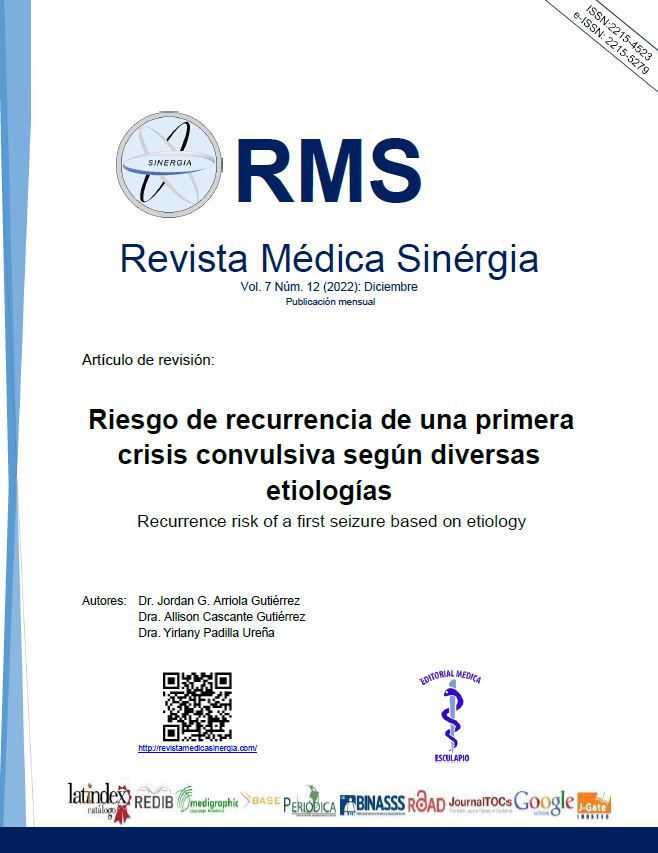Resumen
Según la Liga Internacional Contra la Epilepsia, una convulsión se define como la aparición transitoria de signos o síntomas debidos a actividad neuronal anormal excesiva o sincronizada en el cerebro. La epilepsia, por otro lado, se define como una enfermedad donde hubo dos o más crisis convulsivas no provocadas separadas por más de 24 horas o una única crisis convulsiva con un riesgo mayor al 60% de recurrencia en los siguientes 10 años. Erróneamente, ambos términos se podrían usar de modo intercambiable; no obstante, están cercanamente relacionados el uno con el otro. En el contexto clínico existen condiciones que predisponen a una persona a padecer de epilepsia más allá de una crisis convulsiva aislada, lo que amerita que el personal de atención de salud enfoque su atención a estos pacientes, para poder darles un seguimiento más cercano. Algunas de estas condiciones donde se presenta un riesgo aumentado de convulsiones son la demencia, las apoplejías y el traumatismo craneoencefálico.
Palabras clave
Citas
Fisher RS, Cross JH, French JA, Higurashi N, Hirsch E, Jansen FE, et al. Operational classification of seizure types by the International League Against Epilepsy: Position Paper of the ILAE Commission for Classification and Terminology. Epilepsia. abril de 2017;58(4):522–30.
Falco-Walter J. Epilepsy-Definition, Classification, Pathophysiology, and Epidemiology. Semin Neurol. diciembre de 2020;40(6):617–23.
Rizvi S, Ladino LD, Hernandez-Ronquillo L, Téllez-Zenteno JF. Epidemiology of early stages of epilepsy: Risk of seizure recurrence after a first seizure. Seizure. julio de 2017;49:46–53.
Mc Manus E, Gilbertson L, Timmings P, Lynch C, Asztely F. Long-term outcome of 200 patients referred to a first seizure clinic. Acta Neurol Scand. febrero de 2021;143(2):140–5.
Legg KT, Newton M. Counselling adults who experience a first seizure. Seizure. julio de 2017;49:64–8.
Pohlmann-Eden B, Burneo JG. The broad spectrum of first seizure and newly-diagnosed epilepsy. Seizure. julio de 2017;49:42–5.
Zelano J. Recurrence risk after a first remote symptomatic seizure in adults: Epilepsy or not? Epilepsia Open. diciembre de 2021;6(4):634–44.
Mahamud Z, Mononen CP, Brigo F, Garcia-Ptacek S, Zelano J. Risk of epilepsy diagnosis after a first unprovoked seizure in dementia. Seizure - Eur J Epilepsy. el 1 de noviembre de 2020;82:118–24.
Dulla CG, Pitkänen A. Novel Approaches to Prevent Epileptogenesis After Traumatic Brain Injury. Neurother J Am Soc Exp Neurother. julio de 2021;18(3):1582–601.
Chen M, Edwards SR, Reutens DC. Complement in the Development of Post-Traumatic Epilepsy: Prospects for Drug Repurposing. J Neurotrauma. el 1 de marzo de 2020;37(5):692–705.
Pitkänen A, Paananen T, Kyyriäinen J, Das Gupta S, Heiskanen M, Vuokila N, et al. Biomarkers for posttraumatic epilepsy. Epilepsy Behav EB. agosto de 2021;121(Pt B):107080.
Rabiu TB, Adetunmbi B. Posttraumatic Seizures in a Rural Nigerian Neurosurgical Service. World Neurosurg. agosto de 2017;104:367–71.
Fordington S, Manford M. A review of seizures and epilepsy following traumatic brain injury. J Neurol. octubre de 2020;267(10):3105–11.
Xu T, Yu X, Ou S, Liu X, Yuan J, Huang H, et al. Risk factors for posttraumatic epilepsy: A systematic review and meta-analysis. Epilepsy Behav EB. febrero de 2017;67:1–6.
Yuan WH, Wang SJ. Posttraumatic epilepsy after traumatic brain injury and prophylactic administration of antiepileptic drugs. J Chin Med Assoc JCMA. octubre de 2020;83(10):885–6.
Chen J, Ye H, Zhang J, Li A, Ni Y. Pathogenesis of seizures and epilepsy after stroke. Acta Epileptol. el 4 de enero de 2022;4(1):2.
Zhang Q, Li G, Zhao D, Yang P, Shabier T, Tuerxun T. Association between IL-1β and recurrence after the first epileptic seizure in ischemic stroke patients. Sci Rep. el 11 de agosto de 2020;10(1):13505.

Esta obra está bajo una licencia internacional Creative Commons Atribución-NoComercial 4.0.
Derechos de autor 2022 Array


